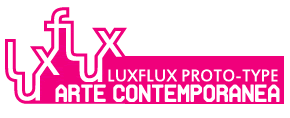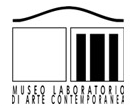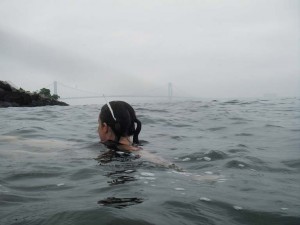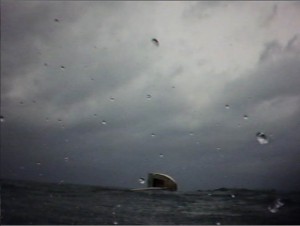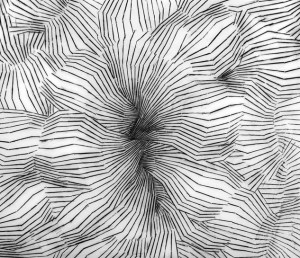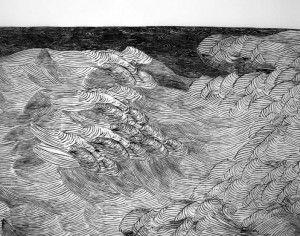(1) She refers at the Dia’s permanent collection – http://www.diabeacon.org
(Dia:Beacon, Riggio Galleries – Beacon, NY).
(2) CLUI, Up River: Man made sites of interest on the Hudson, from Battery to Troy, CLUI, NY, 2008.
(3) UP RIVER: Man made sites of interest n the Hudson, from Battery to Troy on exhibit at the Beacon Institute, Beacon, NY, may 9 – oct 4 2009.
Her artistic’s work and research move from the basic element: the water. Eraclito’s cliché, that contains the principle of eternal becoming and the one of uniqueness; place of union between far countries; place where life goes and history take place. She does in fact a sort of narrative-land art, giving rise to a personal ship’s drawing log made by videos, photographs and visions rendered by interpreted conte on vellum sketch.
In her journey in Rome, Marie Lorenz travelled on her small boat, made by herself, from Trastevere, where the American Academy is, toward Ostia, sailing Tevere and withdrawing this experiences and the landscape, from a different, but very historical, point of view of Rome.
(The Inner Sea, march-may 2009, Pic. 3 –http://www.marielorenz.com/inprogress/?page_id=2007).
In her work it is important the relationship between metropolis and landscape; declarative of a generational change in the conception of landscape, that reveals a point of view, that it is not afraid to assume the urban place as architectural, life living and flow site, in continuity with the natural aspect that constitute it.
Daniela Voso: You are from California, but you actually live in New York. Where did you studied?
Marie Lorenz: I studied Printmaking at the Rhode Island School of Design, and then
received a Master’s Degree at the Yale School of Art in Sculpture.
D.V.: Of course a metropolis, as New York is, offers a lot of boost and Hudson River is an interesting starting point for whom works with water and landscape, as you do. Also New York is a very important site for contemporary art in the world, and a lot of important artists live there, as Louise Bourgeois. How do you relate with this artist, who lives in New York and who reproduce the natural landscape, human’s and animal’s subjects, changed and interpreted, in closed artistic places?
M. L.: Do you recognized any continuity with her in this reproduction of the landscape? I think that every artist owes Louise. I think that my drawings and sculptures outside of the Tide and Current Taxi project – can be seen as a little like her. Narrative, natural forms.
(Pics. 1-2 – http://www.marielorenz.com/tideandcurrenttaxi.php)
I guess the thing that I don’t like is all the focus on childhood – I feel like the art world kind of asks that from woman artists in a way that it doesn’t from male artists, and then artists who play into it art the most successful like Cindy Sherman or Sophie Calle.
I have always liked Louise Bourgeois’ Sunday Salons. Every Sunday she opens her studio for sort of a group critique. Anyone can attend and you have to bring an artwork to talk about. I like this open invitation that does not privilege anyone (make anyone seem more important than another) I also like to look at her work in the context of what was going on throughout her career.
There is a really great exhibition at the Dia Beacon in New York – Richard Serra, Donald Judd, Robert Smithson, all the real ‘heavies’ of that generation (1). And upstairs, kind of away from the rest of the work is a room full of Louise Bourgeois sculptures – spanning her entire career. It doesn’t fit anywhere, it doesn’t look like any of the other work and some of it barely looks like the same artist. I think that is what I like about her – a refusal to mold herself to the current trend.
I might not know enough about her work to make an in depth relation to my own, but yes, I would say I am interested in those ideas of landscape and narrative.
D.V.: Once, when we were talking, you talked about Matthew Coolidge and theCenter for Land Use Interpretation (http://www.clui.org/), a project which works on contemporary land-art. Which are your relation with this project? Do you feel closer to them? Why?
M.L.: I think that CLUI is basically a photographic archive – the same way that my project The Tide and Current Taxi is a photographic archive.
But it has a specific direction and narrative that spells out a point of view.
D.V.: They made and published a book of a project UP River: Man Made Sites of Interest on the Hudson, from Battery to Troy (2), did you take part in this project?
M.L.: That is an area that I have been in my boat. I have also travelled with Matthew Coolidge when he was exploring some rivers in New Jersey.
Seeing the way that he views the landscape and travelling with him, made me think that our projects are similar – a kind of research or exploration for its own sake. The data does not necessarily add up to anything, it is more about the spirit of collecting the data.
D.V.: Which is your idea of land art? Do you think there is a new kind of land art today?
M.L.: When you ask that I would have to say – I think that land art was always photography. Photography was how most of the art public absorbed the information. And I think that CLUI is basically like ‘found object’ land art. The same way that Duchamp found a toilet and then made it a sculpture, CLUI has found these sites and by photographing them and putting the photograph in an art exhibition (3) they have turned environmental disasters into art. It is a very nihilistic approach but then at the same time sensitive and political.
D.V.: Which is your idea of relational aesthetic? Can we talk about your work as a relational art-work? Why?
M.L.: The way I see relational aesthetic was a move to put everyday activities into an institution. Like Rirkrit Tiravanija cooking food in a museum. For a time it was a way to look at the institution in a fresh light. It seemed wrong and out of place and that was enough. I think my work can be seen as a relational project because it is a direct interaction with the viewer. But the difference is that it has nothing to do with an institution. Because of the internet, I have made the museum unnecessary. People can link with the art in a more immediate way. Sometimes when people look at the web site they don’t even know that they are looking at art.
The fact is, an institution can’t host the Tide and Current Taxi. Because of liability issues in the United States, the project can’t be supported in any way. I didn’t mean to do it at the time, but I have made a project that must, by its very nature, live outside the bounds of the institution.
D.V.: At the end of this journey in Rome, which are the aspects that you’ll bring back and that gave you something new?
M.L.: The biggest change in my work was the video that I made while testing out my boat at Ostia Lido. I attached a small camera to the front of the boat and when it tipped over and began to sink, I removed the camera a swam to shore. The video camera picked up everything and what I was left with, was a very strange and beautiful 7 minute image. It was hard for me to think of the video as a work of art, because I had not planned it out and worked on it in the same way that I am used to working on projects. But when I came to terms with it, I found it to be one of the most compelling things that I have ever made. I think it was an important step to let go off the way that I usually make art and allow a huge mistake to enter in – to take center stage. I would like to find ways to allow accidents into my artwork more – not in a way that could be dangerous, but in a way that is unexpected.
July 2009
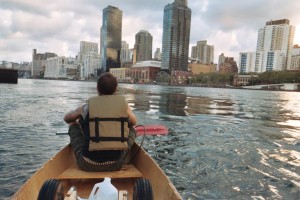
From the top:
The Tide and Current Taxi, Photograph(from Blog), 2005, East River, New York City
The Tide and Current Taxi, Photograph (from Blog), 2007, New York Harbor, New York City
Vortex, 2009, Conte on Vellum, 20″ x 30″ (inches)
Waves, 2009, Conte on Vellum, 40″ x 60″ (inches)
All pictures courtesy of the artist
